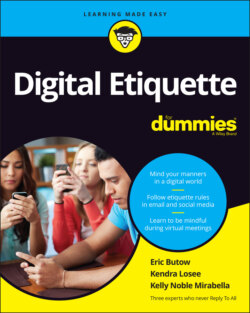Читать книгу Digital Etiquette For Dummies - Eric Butow - Страница 7
ОглавлениеIntroduction
Well, look at you. We’re proud of you for taking steps to become a responsible citizen online by learning about digital etiquette, also called netiquette. You wouldn’t be reading an actual printed book unless you wanted to sit in a comfortable chair, set your favorite beverage on the table next to you, and soak it all in.
We have a lot of good stuff to share with you to make you a better person online — and you may be surprised that you’ll see how to be a better human being here in real life. If you read this entire book, your mindset will change, and others’ perceptions of you will change for the better.
About This Book
The purpose of Digital Etiquette For Dummies is to help you communicate effectively online. The number of pages in this book has tipped you off that doing so is easier said than done. After all, we can just say that you have to be nice to people, but there’s a lot to unpack in that simple concept.
It's not just behaviors that you need to know about and refine — you also need to know about laws governing online behavior, because the wild west approach to communicating on the Internet started to disappear decades ago. That’s not just true of spam (a friendly reminder that this kind of spam has nothing to do with the processed meat you can buy) but also of data privacy.
So we start by defining etiquette in the digital age. We talk about spam and privacy laws not just in the United States as a whole but also in individual states as well as specific countries and regions. And we talk about communicating effectively — no matter your age and no matter what forum (including social media posts and groups, virtual meetings, livestreams, and phone conversations).
Foolish Assumptions
When writing this book, we assumed that at least one of the following statements describes you:
You are a human being who wants to better connect with fellow human beings.
You have a business and you want to communicate more effectively with current and prospective customers.
You are committed to devoting time and energy to make yourself a better communicator.
If these assumptions are correct, this is the right book for you! We’re confident that the tactics and information here can help you achieve your goals.
Icons Used in This Book
To make things easier and ensure that you don’t miss important details, we have made use of various icons throughout this book. Here’s what the different icons look like and mean:
The Tip icon is a small piece of expert advice that saves you time and makes your experience online more enjoyable.
Because we cover a lot of details and information, every now and then we throw in the Remember icon to remind you of important details we've already covered. We know you’re reading every juicy detail of the book; the Remember icon just helps resurface some of those tidbits.
Who doesn’t love a little geekfest on technical jargon? Okay, a lot of people! But that’s why we’ve pulled out these paragraphs so that you can understand the technical aspects of digital etiquette without getting overwhelmed.
Yes, this book has a few warnings. When you see the Warning icon, please take a few extra moments to understand the effect of what we're saying.
Beyond the Book
In addition to what you’re reading right now, this book comes with a free, access-anywhere Cheat Sheet that provides a handy list of digital etiquette rules as well as strategies for navigating the Internet with aplomb. To view the Cheat Sheet, simply go to www.dummies.com and type Digital Etiquette For Dummies Cheat Sheet in the Search box.
Where to Go from Here
The first three chapters in Part 1 introduce you to digital etiquette, including what digital etiquette is (and isn’t), laws and policies, setting and respecting boundaries, and rules for everyone at all age levels, from kids to adults.
We think you should at least familiarize yourself with the concepts in the first three chapters because you need to know the concepts in Part 1 so that you can conquer digital etiquette in Part 2. If you deal with email often, you’ll want to focus on Part 3. (It not only talks about email etiquette but also fills you in on what you need to know so that you don’t run afoul of legal trouble in your email marketing campaigns.)
After that, we have a lot of information about virtual meetings, which were already popular before the COVID-19 pandemic propelled interest in that topic into the stratosphere. And let’s not forget mobile etiquette. (Part 5 talks about not only text messaging but also how to be polite when you’re talking on your phone.) If you want to focus on a specific area, the table of contents will guide you to where you want to go.
Now it’s time to get started reading about what etiquette is and how to use it in your online communication. Enjoy the book!
